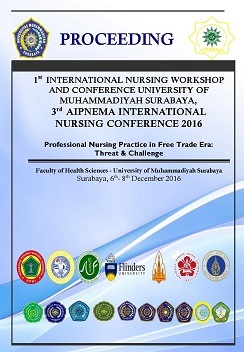The Differences Level Of Brain Derived Neurothropic Factor (Bdnf) Hipocampus Wistar In Rats Are Given Physical Exercise Aerobic 1 Times A Week
Abstrak
Introduction: Physical exercise aerobically can increase the production of growth factors such as Brain Derived Neurothropic Factor (BDNF). BDNF plays a role in the process of neurogenesis with a positive impact on cognitive function. This study aims to determine whether there is a relationship between levels Neurothropic Brain Derived Factor (BDNF) in rats fed aerobic exercise and aerobic exercise are not given. Methods: This study is an experimental research laboratory with post test only control group design. The subject of research in the form of Rattus norvegicus Wistar strain amounted to 35 rats were divided into one control group and the treatment group, namely; aerobic exercise group with a frequency of 1 time per week of physical exercise done using animal treadmill at a speed of 20m / min for 30 minutes of aerobic physical exercise. Results: An increase in BDNF levels of hippocampal tissue both in aerobic exercise group (133.4 ± 2,97pg / mL) compared with the control group (55.27 ± 4.18 pg / mL). Conclusion: There is a difference between the levels of BDNF hippocampal tissue in mice fed aerobic exercise compared with control mice.
Â
Keywords: physical exercise, BDNF, Brain Tissue
Â
Referensi
Badger P, 2009. Processing Cost Analysis for Biomacy Feedstocks General Inc. Florence Alabama Date Published October
Baoji Xu, BDNF (I) Rising from Exercise Department of Neuroscience, The Scripps Research Institute Florida, Jupiter, FL 33458, USA Correspondence: bxu@scripps.edu http://dx.doi.org/10.1016/j.cmet.2013.10.008
Carro,E., Nunez,A., Busiguina,S., and Torres-Aleman,I. (2000). Circulating insulin-like growth factor I mediates effects of exercise on the brain. J. Neurosci. 20, 2926-2933.
Cetinkaya, Caner. Et.al (2013). Positive effects of aerobic exercise on learning and memory functioning, which correlate with hippocampal IGF-1 increase in adolescent rats. Article in neuroscience Letters.
Cotman CW, et al, 2007 Exercise builds brain health : key roles of growth factor cascades and inflamation. University Of California
Cowen, et al.2007 Interaction of FGF-2 with IGF-1 and BDNF in Stimulating Akt, ERK, and Neuronal Survival in Hippocampal Cultures
Dahlan.S.M..2009.Statistik untuk kedokteran dan kesehatan.Seri evidence based medicine 1.Edisi 4.Salemba medika.
Dufaux.B, Hoederath.A, Streitberger.I, Hollmann.W, Assmann.G.2001. Serum ferritin, transferrin, haptoglobin and iron in middle and long distance runners, elite rowers, and professional racing cyclists. Int Journal Sports Med 2:43–46.
Eadie, B. D., Redila, V.A, and Christie, B. R. (2005). Voluntary Exercise Alters The Chyotoarchitecture of the Adult Dentate Gyrus by Increasing Cellular Proliferation, Dendritic Complexity, and Spine Density. J. Comp. Neurol. 486, 39–47.
Flora, Rostika, 2015. Jantung dan latihan Fisik. UNSRI Press
Foster Rascublatt K.P Kuljur. 2011. Exercise Induced Cognitive Plasticity, Implications for mild coqnitive impairment and Alzheirmer’s Disease. Frontiersbin Neorology Dementia
Gomez, pinila et al. 2004. Hippocampal BDNF mediates the efficacy of exercise on synaptic plasticity and cognition.
Gorski JA, Zeiler SR, Tamowski S, Jones KR. 2003. Brain Derived Neurothropic Factor Is Required or The Maintenance Of Cortical Dendrites, J Neurosci.23 : 6856-6865
H.Van Praag,G. Kempermann,F.H.Gage, 1999.Running Increases cell Proliferation and Neurogenesis in the adult mouse dentate gyrus.Nat. Neurosci.266-270
Konrad, et al, Defining the human hippocampus in cerebral magnetic resonance images—An overview of current segmentation protocols,Published in final edited form as: Neuroimage. 2009 October 1; 47(4): 1185–1195. doi:10.1016/j.neuroimage.2009.05.019
Markowska AL. 1998.Sex Dimorphism in the rate of age related in spatial memory : relevance to alterations in the estrous cycle. J. Neuroski. 19-8122-8133
Molteni, Raffaella, Zhe Ying and Fernando GoÂmez-Pinilla. 2002. Differential effects of acute and chronic exercise on plasticity-related genes in the rat hippocampus revealed by microarray. European Journal of Neuroscience, Vol. 16, pp. 1107±1116.
Vaynman S., Ying Z., Gomez - Pinilla F. (2004). Hippocampal BDNF mediates the efficacy of exercise on synaptic plasticity and cognition. European Journal of Neuroscience. Vol. 20, pp. 2580–2590.
Russo-Neustadt A, Ha T, Ramirez R, et al. (2001): Physical activity-antidepressant treatment combination: impact on brain-derived neurotrophic factor and behavior in an animal model. Behav Brain Res, 2001, 120: 87–95. [Medline]
Sherwood.2001. Fisiologi Manusia dari Sel ke Sistem. Jakarta : EGC.
Silverthorn, Dee Unglaub. (2014). Fisiologi Manusia Sebuah Pendekatan Terintegrasi. Penerbit Buku Kedokteran EGC ; Jakarta.
Swain RA, Berggren KL, Kerr AL, Patel A, Peplinski C, Sikorski AM.2012. On Aerobic Exercise and Behavioral and Neural Plasticity. Brain Sci. 709-44.
Thomas AG, Dennis A, Bandettini PA, Johansen H. 2012.The effect of aerobic activity on brain structure. Frontiers in Physiology. (86): 1-9
Zhang, Q., Wu, Y., Zhang, P., Sha, H., Jia, J., Hu, Y., and Zhu, J. (2012). Exercise induces mitochondrial biogenesis after brain ischemia in rats. Neuroscience 205, 10–17.






